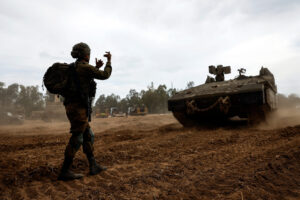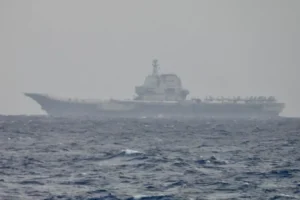In the Baltic Sea region Russia has strengthened its quantitative and qualitative advantage. This chapter is part of CEPA’s report on Baltic Sea Security Close to the Wind.
This report’s predecessor, “The Coming Storm” (2015), noted that though the five Nordic countries, three Baltic states and Poland had a GDP greater than Russia’s, and had defense budgets that on paper could easily match Russia’s aggressive capabilities, their “generally weak defense spending and poor coordination” made them highly vulnerable to a “multi-pronged and sustained military, propaganda and espionage offensive from Russia.”1 It warned that not only regional security, but NATO’s credibility was, therefore, at stake.
As this interim report outlines, much has changed since then. The war in Ukraine, the refugee crisis, the covid-19 pandemic, Brexit, and the Trump administration’s “America First” approach have presented new challenges to the European Union (EU) and NATO. Though the combined forces of NATO countries, or even of European NATO allies alone, greatly exceed Russia’s, in the Baltic Sea region Russia has strengthened its quantitative and qualitative advantage.
One informed estimate is that Russia could muster around 125,000 high-readiness ground forces in 14 days. Poland, the region’s military heavyweight, could probably muster two divisions in 10 days, numbering about 40,000 troops. Deployed to the Lithuanian border this would be a potent counterweight to Russian aggression. But Poland would be reluctant to act alone: political and military support from NATO allies, chiefly the United Kingdom and the United States, would be vital. The reliability of such reinforcement depends on repeated realistic practice. This is currently lacking.
Russia has also honed and developed its subthreshold warfare capabilities, lately known as “hybrid” or “active measures” by those who remember similar Soviet-era tactics. Continuing “near-miss” aviation and naval maneuvers, snap exercises, and harassment of civilian infrastructure projects have both military and psychological effects. The countries of the region have reacted. In 2015, Poland and Estonia were the only two countries in the region to meet NATO’s 2% of GDP defense-spending target. Now:
- Latvia and Lithuania meet that target.
- Finland will reach it in 2021.
- Sweden, after its post-Cold War “strategic time-out,” is to raise its spending by 40% over the 2021-2025 period to around 1.5% of GDP, the biggest increase in 70 years.2
- Denmark, having also neglected territorial defense, is raising its spending to 1.5% of GDP by 2023.3
- In 2020, Poland allocated nearly 2.4% of GDP to defense and plans to reach 2.5% by 2030.
As later sections in this report outline, money has brought improvements in capabilities. The scale, pace, and number of military exercises and the combinations of countries involved have increased sharply. Security arrangements have strengthened too: bilateral, regional, and multilateral, involving the United States, the U.K., France, and all the countries of the region in different permutations. We have counted at least 10 in total, outlined later in the report.
In particular:
- NATO’s role in the region has transformed.
- The enhanced Forward Presence (eFP) in the Baltic states and Poland has created a significant land-based contribution to national defense efforts in these countries.
- Baltic Air Policing deployments have increased.
- NATO has two divisional and one corps headquarters in the region.4
- NATO Force Integration Units (NFIUs) are tasked with organizing Host Nation Support (HNS) for allied forces in the event of a crisis.
- The U.S. presence in the Baltic Sea region has increased.5
- Finland and Sweden have sharply strengthened their security cooperation, and their bilateral and trilateral ties with the United States. A U.S. Army Green Beret team is stationed full-time in Sweden.
- Poland, NATO’s eastern flank hub and military heavyweight, is now closely working with Baltic countries, particularly Lithuania.
- EU defense cooperation with NATO has improved, at least on paper, with the establishment of the Joint Support and Enabling Command (JSEC) headquarters in Ulm, Germany, to improve logistics and mobility. However, most EU defense efforts have yet to be realized.
The combination of stronger security cultures, greater national capabilities, and more credible external involvement has improved deterrence and defense. The region’s strategic incoherence has in some respects abated. Trust across the four main fault lines in the region — big/small, rich/poor, NATO/non-NATO, and EU/non-EU — has grown (see box “Trust, But Verify: The Center of Gravity of Regional Security”). It is hard to identify a period in recent history when national efforts and regional security ties were stronger.
As this interim report and its successor will outline, much remains to be done. But the shortcomings can be exaggerated. A RAND Corporation study, for example, conducted wargames in 2014 and 2015 to examine “the shape and probable outcome of a near-term Russian invasion of the Baltic states.” It concluded:
“As currently postured, NATO cannot successfully defend the territory of its most exposed members. Across multiple games using a wide range of expert participants in and out of uniform playing both sides, the longest it has taken Russian forces to reach the outskirts of the Estonian and/or Latvian capitals of Tallinn and Riga, respectively, is 60 hours. Such a rapid defeat would leave NATO with a limited number of options, all bad: a bloody counteroffensive, fraught with escalatory risk, to liberate the Baltics; to escalate itself, as it threatened to do to avert defeat during the Cold War; or to concede at least temporary defeat, with uncertain but predictably disastrous consequences for the Alliance and, not incidentally, the people of the Baltics.”6
The report recommended that:
“A force of about seven brigades, including three heavy armored brigades, supported by airpower, land-based fires, and other enablers should be on the ground and ready to fight at the onset of hostilities, at an annual cost of around $2.7 billion.”
We do not share this diagnosis or the proposed remedy. The proposed force would be militarily and financially unsustainable, and likely to lead Russia to further increase its military posture in the region. More broadly, it is a mistake to think about defense of the Baltic states as if no other theaters would be involved. The RAND study does not consider the breadth and flexibility of NATO’s deterrence and the vulnerability of other parts of Russia to a military confrontation, not least in the newly accessible Arctic. Nor does it include Ukraine. The war there ties up a substantial number of Russian forces that would be needed in any conflict with the West.
This report is only the first part of our research. It highlights shortcomings and successes, but without making specific recommendations on future policy choices and priorities. A second report will suggest to decision-makers at a national and multilateral level what they should do in the future — and just as importantly, what they should not do.
Trust, But Verify: The Center of Gravity of Regional Security
Our previous report, “The Coming Storm: Baltic Sea Security,” highlighted the lack of trust between decision-makers in the Baltic Sea region. We warned, for example, of Polish unease that its relative strength would make it the loser “in any arrangement that involves smaller, weaker and more muddle-headed countries.” Polish leaders told us forcefully that whatever NATO plans might say, in a real crisis they would not consider deploying the best part of their country’s armed forces to defend the Baltic states: these units would be needed to defend Warsaw.
Conversely, we noted that “the Nordic and Baltic countries fear Poland’s political unpredictability.” Danish decision-makers expressed grave doubts about any security arrangements that might compromise the centrality of NATO. Their Swedish and Finnish counterparts expressed unease about being dragged into a U.S.-led confrontation with Russia. The highest level of trust in the region, counterintuitively, was between Finland and Estonia: countries that spanned the old/new Europe divide, as well as the NATO/non-NATO one.
A qualitative survey of around 50 security experts and decision-makers by CEPA in early 2021 assessed the level of trust between the 10 allies and partners in the region and reveals a noticeable change in this picture.
The biggest change is that defense and security cooperation between the Baltic states and Poland has intensified and flourished in the past six years. Polish officials now readily say that their country’s defense perimeter begins on the Estonian-Russian frontier.
Swedish defense cooperation with Poland, which we highlighted as a promising new development in 2015, has failed to reach its potential. The lowest trust score revealed in our survey, of 5.41 out of a possible 10 points, was between Poland and Sweden, closely followed by Poland and Germany at 5.59. Polish-Finnish trust was only marginally higher.
The highest level of trust, at 7.91, was recorded between Sweden and Finland, the two non-NATO countries in the region. However, the runner-up, at 7.77, was Estonia and Finland, highlighting closeness of ties between these countries divided by income level, NATO membership, and size. In third and fourth place, some way behind, came Denmark and Norway (7.5) and Denmark and Germany (7.41).









